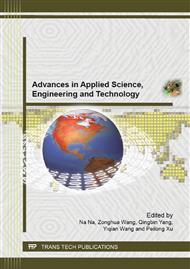[1]
Victor C. Li. On Engineered cementitious composites: a review of the material and its applications[J]. Adv Concrete Technol, 2003, 1(3): 215–30.
Google Scholar
[2]
Bentur A, Mindess S. Fiber reinforced cementitious composites[M].Amsterdam: Elsevier Science Publishers, (1990)
Google Scholar
[3]
Kanda T. Design of engineered cementitious composites for ductile seismic resistant elements, in department of civil and environmental engineering[D]. Ann Arbor: University of Michigan, (1998)
Google Scholar
[4]
Y.Y. Kim, H.-J. Kong, Victor C. Li, Design of engineered cementitious composite suitable for wet-mixture shotcreting[J]. ACI Materials, 2003, 100 (6):511 –18
DOI: 10.14359/12958
Google Scholar
[5]
Akkaya Y, Shah SP, Ankenman B. Effect of fiber dispersion on multiple cracking of cement composites[J]. Eng Mater Civil Eng 2001, 127(4): 311–316
DOI: 10.1061/(asce)0733-9399(2001)127:4(311)
Google Scholar
[6]
Ozyurt N. Correlating fiber dispersion, rheology and mechanical performance for fiber- reinforced cement-based materials[D]. Istanbul, Istanbul Technical University, (2006)
Google Scholar
[7]
Su-Tae Kang,Jin-Keun Kim. Investigation on the flexural behavior of UHPCC considering the effect of fiber[J]. Constr Build Mater, 2012, 28: 57–65
Google Scholar
[8]
Jian Zhou, Shunzhi Qian, et al. Improved fiber distribution and mechanical properties of engineered cementitious composites by adjusting the mixing sequence. Cement Concrete Comp (2011), doi: 10.1016/j. cemconcomp.2011.11.019
DOI: 10.1016/j.cemconcomp.2011.11.019
Google Scholar
[9]
Bang Yeon Lee, et al. Quantitative evaluation technique of Polyvinyl Alcohol (PVA) fiber dispersion in engineered cementitious composites[J]. Cement and Concrete Composites, 2009, 31: 408-17
DOI: 10.1016/j.cemconcomp.2009.04.002
Google Scholar
[10]
De Koker D, van Zijl G. Extrusion of engineered cement-based composite material. In: di Prisco M, et al., editors. Proceedings 6th RILEM symposium on FRC, 2004: 1301–10
Google Scholar
[11]
Takashima H, Miyagai K, et al. A design approach for the mechanical properties of polypropylene discontinuous fiber reinforced cementitious composites by extrusion molding[J]. Engineering Fracture Mechanics, 2003, 70: 853-70
DOI: 10.1016/s0013-7944(02)00154-6
Google Scholar
[12]
Evans KE, Gibson AG. Prediction of the maximum packing fraction achievable in randomly oriented short-fibre composites[J]. Compos Sci Technol, 1986, 25:149–62
DOI: 10.1016/0266-3538(86)90040-0
Google Scholar
[13]
Lin JZ, Sun K, Zhang W. Orientation distribution of fibers and rheological property in fiber suspensions flowing in a turbulent boundary layer[J]. Acta Mech Sinica, 2008, 24:243–50
DOI: 10.1007/s10409-008-0152-3
Google Scholar
[14]
Moses KB, A vani SG, Reinhardt A. Investigation of fiber motion near solid boundaries in simple shear flow[J]. Rheol Acta, 2001, 40:296–306
DOI: 10.1007/s003970000135
Google Scholar
[15]
Su-Tae Kang, Jin-Keun Kim. Numerical simulation of the variation of fiber orientation distribution during flow molding of Ultra High Performance Cementitious Composites (UHPCC) [J]. Cement and Concrete Composites, 2012, 34: 208-217
DOI: 10.1016/j.cemconcomp.2011.09.015
Google Scholar
[16]
B. Boulekbachea, M. Hamrata, et al. Flowability of fiber-reinforced concrete and its effect on the mechanical properties of the material[J]. Constr. Build. Mater, 2010, 24 (9): 1664 –71
Google Scholar
[17]
S.J. Barnett, J.F. Lataste, et al. Assessment of fiber orientation in ultra high performance fiber reinforced concrete and its effect on flexural strength[J]. Mater. Struct, 2010, 43 (7):1009–23
DOI: 10.1617/s11527-009-9562-3
Google Scholar
[18]
L. Martinie, N. Roussel. Simple tools for fiber orientation prediction in industrial practice[J]. Cement and Concrete Research, 2011, 41: 993-1000
DOI: 10.1016/j.cemconres.2011.05.008
Google Scholar


